


At Kirlough Family Dentistry, we want to help every patient struggling with tooth loss discover the reconstructive solution that fits their personal preferences and available budget. One of the best options available today is dental implants, which offer incredible stability, aesthetic value, and longevity. In fact, implant-retained teeth are virtually indistinguishable from natural ones when completed! To explore this transformative service in greater detail, contact us today and schedule a consultation with Dr. Kirlough.
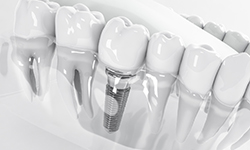
A dental implant resembles a small screw; you wouldn’t think it’s meant to replace teeth just by looking at it. However, the implant is actually meant to provide support for a crown, a bridge, or a denture; the prosthesis fills in the gap in your grin while the implant post provides stability and chewing power. Dental implants are different from other tooth replacement options because they can act as new tooth roots by virtue of being surgically placed in the jaw.

At another dentist’s office, getting dental implants may involve visiting a separate periodontist or oral surgeon, which can mean more travel time and having to see a team that you’re unfamiliar with. But at Kirlough Family Dentistry, we can handle every step of the implant process in-office, which can make things much more convenient for you overall! Here’s what you can expect to happen when you decide to rebuild your smile with dental implants.
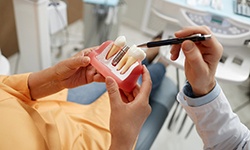
Step one is to visit our office for a consultation. Our team will need to evaluate the state of your mouth as well as your jawbone; once that’s done, we can determine whether you’re a viable candidate for dental implants. Sometimes we may recommend undergoing bone grafting or another type of preliminary procedure to address any issues that might get in the way of having dental implants placed.

On the day of your dental implant surgery, a local anesthetic will be applied to your mouth to prevent you from experiencing any discomfort. If you’re nervous, you can ask to have sedation performed to help you stay calm.
Once we’re ready to begin the surgery, we’ll create an opening in your gums. This allows us to work with the underlying bone. The dental implant posts will be carefully placed in strategic locations throughout your jaw. Once all of the posts are where they need to be, your gums will be closed again.
Protective caps will be attached to each implant post. These caps serve a twofold purpose: they keep the implants safe from damage, and they ensure that the surrounding tissues are able to heal properly.
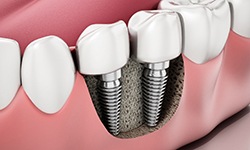
Your dental implants won’t be able to support replacement teeth right away. First, they need to merge with the bone through a process known as osseointegration. The exact timeline for osseointegration can vary from patient to patient, but it’s usually between three and six months.
After osseointegration comes the placement of abutments, which are small pieces of metal that will ultimately be used to secure your new dental prosthesis in place. An abutment will be carefully attached to each implant post.
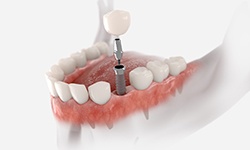
We’ll take impressions of your mouth in order to determine the proper shape and size for the final implant restoration. Then your new crown, bridge, or denture will be created at a trusted dental lab. The completed prosthesis will be sent to our office, and we will schedule one last appointment so that we can complete your smile.
Once the prosthesis has been attached to the implant posts, it will blend right in with your natural teeth. To the casual observer meeting you for the first time, it will look as though your smile never had any gaps to begin with.
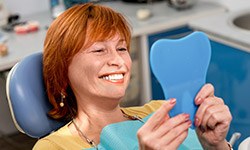
Your natural tooth is composed of two distinct components. The one everyone is most familiar with is the white crown that you see when you smile, but there is also a tooth root that’s well-hidden underneath the gum tissue. Without a functioning tooth root in place, the jawbone doesn’t have any stimulation and will begin to deteriorate, which is why so many older people have a “hunched” facial appearance. Unlike more traditional services, dental implants are the only current reconstructive option that actually rebuild the root in addition to the crown, improving oral health in significant, lasting ways. Additional benefits include:

Dental implants are versatile enough to correct a wide spectrum of tooth loss, and Dr. Kirlough will help patients pair them with the ideal restoration for their specific needs and preferences.
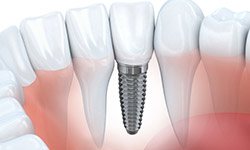
A metal-free, implant-retained crown can be combined with a singular implant. The new “tooth” will fit in right alongside the rest of your smile, and unlike traditional dental bridges, we won’t have to remove a significant amount of healthy dental structure to accommodate its placement.
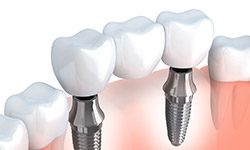
Implant-retained bridges are an excellent choice for replenishing multiple missing teeth that used to appear in a row. Instead of reducing natural teeth to accommodate the new replacement, we can place two dental implants – one on either side of the gap – to anchor the new prosthetic securely in place.
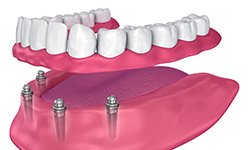
Implant-retained dentures are a cost-effective solution for replacing several teeth at once (even entire arches) while still providing a reliably high level of quality. Instead of placing one implant per lost tooth, a small number of implants can be angled strategically in the jawbone to support a full, custom prosthetic all at once.
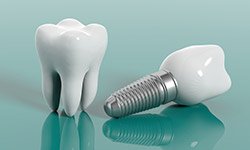
Determining the cost of dental implants is a complex question because this procedure has several components to it – there’s the initial surgical placement of the implant(s), the addition of an abutment (connector), and the design and creation of custom-made restorations. Dr. Kirlough can provide confident, all-inclusive price estimates after an initial consultation, during which he will thoroughly review your oral health and discuss your personal preferences for the treatment process.
We encourage patients to keep in mind that while dental implants may seem more expensive at first glance, they can actually end up costing you less over time because they won’t require the same amount of extensive maintenance as more traditional tooth replacement services. They’re designed to thrive for decades or even the rest of the patient’s life!

Because we place dental implants in-house, we make a point of keeping up with the latest techniques and advancements for the treatment. Every step of the process needs to be planned, from the actual placements to designing and attaching the implant crown. To help with the process, we make use of our state-of-the-art TRIOS scanner, allowing us to create fully customized restorations that blend in perfectly with the rest of your smile once they have been attached to the implant posts. Read on to learn more about how this instrument plays a critical role in planning your treatment.
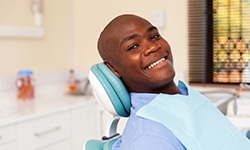
The TRIOS digital scanner is an advanced instrument for taking dental impressions. You might be familiar with the foul-tasting, uncomfortable putty that patients used to have to bite down on in order to create molds of their teeth. Not only was this method unpleasant, but it often had to be redone due to error. But with TRIOS, the process is much more comfortable and convenient; we simply scan the inside of your mouth to create a digital model that aids us in designing restorations and planning treatments. The accuracy of the scan means mistakes are much less likely, ensuring you get a properly personalized restoration the first time.
What does this mean for the dental implant process? Taking accurate, detailed impressions is a must if you want your final restoration to look and feel as natural as possible in your mouth after it has been anchored to your implants. With the information captured by the scanner, we can design a restoration that matches the shape, size, and color of your other teeth so that the average observer won’t be able to tell that you ever had any gaps in your grin.
Once your implants have fully integrated with your jaw and an abutment has been attached to each post, we can use TRIOS to take a digital impression of your smile in its current state. (It is important that we do this after your mouth has fully healed so that your implants are in the right position and your gums are the correct shape.) The scanner is inserted into your mouth to capture images of your teeth and implants from every angle. The results will be displayed on a screen immediately afterwards; this way, we can show you the current condition of your smile and explain the next steps in full detail.
Compared to traditional impressions, TRIOS digital scans are completed much faster and allow for a more accurate fit the first time. They can also be used to highlight specific details of your smile to aid with the designing process. Feel free to ask about our TRIOS scanner – and any other technology that we use to place and restore implants – at your initial dental implant consultation; it always helps to know exactly what you can expect.
While more people are candidates for dental implants than ever before, there are a few requirements that you’ll need to meet before you can safely receive them. For example, you should have healthy gum tissue so it can effectively heal around the implant after it is placed. Furthermore, you should have sufficient bone tissue for the implant to integrate in. Once you meet these requirements, you’re eligibility to receive dental implants goes up significantly.
When placed by a dental professional, dental implants are very safe. In fact, they often boast an average success rate that falls between 95% and 98%. Over the several decades that dental implants have been around, dentists have nearly perfected the treatment and made it more predictable than ever before. To ensure a safe placement, we’ll take all the necessary precautions during the planning phase of care. This should give you and your family member confidence, but you’re always welcome to ask any questions during these planning stages.
Dental implants do not require any special care to be maintained. Rather, you only need to practice routine brushing and flossing every day as well as visit our office for a routine checkup every six months. This is just one of the many benefits of choosing a tooth replacement that’s designed to mimic natural teeth so closely. With that said, those with larger, more complex restorations (such as implant-retained dentures) will need to make sure to clean underneath the bridge at least once a day.
The problem with tooth loss is that once a tooth is gone, the rest of the mouth will respond accordingly. For example, the bone inside the jawbone will begin to break down, weakening the jaw and increasing the risk of future tooth loss. Additionally, when teeth are removed, remaining teeth will begin to move into the open space as a way to compensate. By replacing even just one tooth, you’re taking the steps to avoid multiple dental problems later in life.
Once a dental implant is placed, it is not meant to be removed ever. The only occasion in which it would be is if the implant has failed. With that said, the restorations that attach to the implants are also not meant to be removed. However, there are specific exceptions, such as when a patient requests an implant-retained denture that can be removed for cleaning. Even then, the implants always stay inside the jaw.